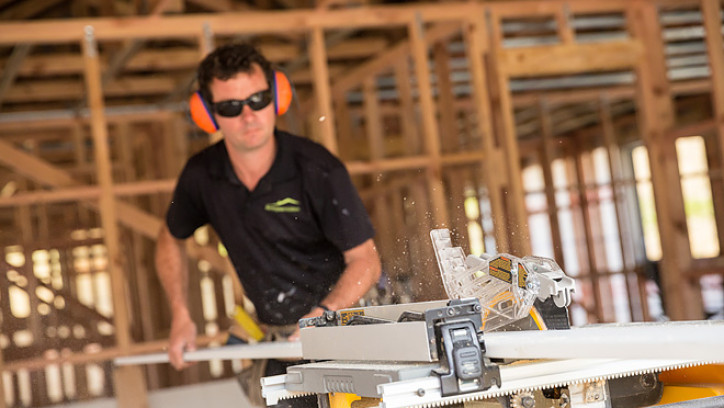Timber construction
Last updated: 9 August 2023

Timber framing is the most common home construction system in New Zealand
Key features of timber construction
There are several forms of timber construction, including timber framing, post and beam, and solid timber.
Most of the timber used in New Zealand construction is sourced locally from sustainably sourced materials.
In most cases, timber that may be exposed to water at some point requires chemical treatment to avoid fungal decay and insect attack.
Timber and your site
Climate
Timber construction is suitable for all climate conditions. Timber exposed to the exterior needs regular maintenance (such as cleaning, staining or painting) to prevent damage and decay. Timber exposed to harsh sunlight may split, check and discolour over time.
Fixings that are exposed to the exterior must be suitable for the corrosion zone they are to be used in to avoid premature corrosion and rust staining of the timber.
Topography and site impact
Timber is a lightweight construction material. It is often used on sloping sites to minimise site excavation.
Types of timber construction
Timber-frame construction
Timber framing is New Zealand's traditional method of house construction.
Timber-frame construction is lightweight, strong, and resilient. It is reasonably easy to modify after construction for additions or alterations. The design of this type of home is familiar to architects, designers, builders and building control officers.
Post and beam construction
Timber post and beam construction consists of a skeleton of timber posts and beams. This gives an open plan with very little or no obstruction of the interior space. This also allows the roof to be built quickly, providing shelter for construction of exterior walls, partitions and fittings.
The bays between the posts are filled in and braced to form the exterior walls. Post and beam is often used with mud brick or straw bale construction.
Other types of construction has more information.
Post and beam construction is particularly compatible with large open plan spaces, and also for homes where a flexible layout is required. Because of the lack of load-bearing internal walls, interior partitions can easily be removed or relocated.
Solid timber construction
There are a number of solid timber options available in New Zealand, from log cabins to tongue-and-groove style interlocking wall systems.
The exterior is weather-proofed using a combination of surface protection (often with aluminium sheathing or a suitable paint system) and eaves.
Solid timber walls typically need additional insulation to meet the thermal performance requirements of the New Zealand Building Code. This is typically done through the use of an insulated cavity with sheet lining or an additional layer of timber boards on the interior, or planks with a layer of insulation sandwiched between the two faces.
Houses can be built from solid timber. Some are 'log cabin' style. Others use thick timber planks that lock together.
Timber floor options
Timber floor construction consists of timber joists covered with floorboards or particle board panels.
Timber floor construction is lightweight and can be useful for sites with softer ground conditions. It is also useful for sloping sites as it reduces or eliminates the need for excavation (although the topsoil will still need to be removed).
Insulation must be installed under the ground floor to prevent heat loss and meet the thermal performance requirements of the New Zealand Building Code.
Timber pole foundations
Houses can be built on steeply sloping sites using timber poles to support the building.
This allows building with minimal disturbance of the ground and existing vegetation.
In some hilly areas of New Zealand it is common to see houses, garages and car pads supported on poles.
The poles must meet the 50-year durability requirement of the New Zealand Building Code. They are chemically treated to resist rot and insect attack.
Timber pile foundations
Timber piles can be used to support the floor. Typically piles are used where the site is reasonably level or has a gentle slope. Depending on the type, they may need to be firmly concreted into the ground to prevent any settling (driven piles don’t necessarily have a concrete footer). Timber in contact with the ground is chemically treated to withstand rot and insect attack.
In new homes, the New Zealand Building Code requires sufficient sub-floor ventilation to keep moisture levels down and prevent dampness rising into the house. A layer of polythene sheeting on the ground in enclosed subfloor spaces is one of the most cost-effective ways to reduce moisture in existing homes.
Homes on timber piles need to be high enough to allow for access under the floor by tradespeople, and high enough to keep the house above flood levels with a certain expected return period – your designer will deal with this as part of the consent process. You can ask your designer to make the floor level higher to increase your home’s resilience to severe flooding events.
Timber flooring
Timber flooring comes in a number of formats, including solid timber tongue and groove (which can be both a flooring material and a finish), and sheet materials such as chipboard or plywood that are then covered with a variety of finishes.
Chipboard tends to swell when exposed to water, so it's a good idea to specify a more moisture-resistant material in wet areas such as bathrooms, kitchens and laundries.